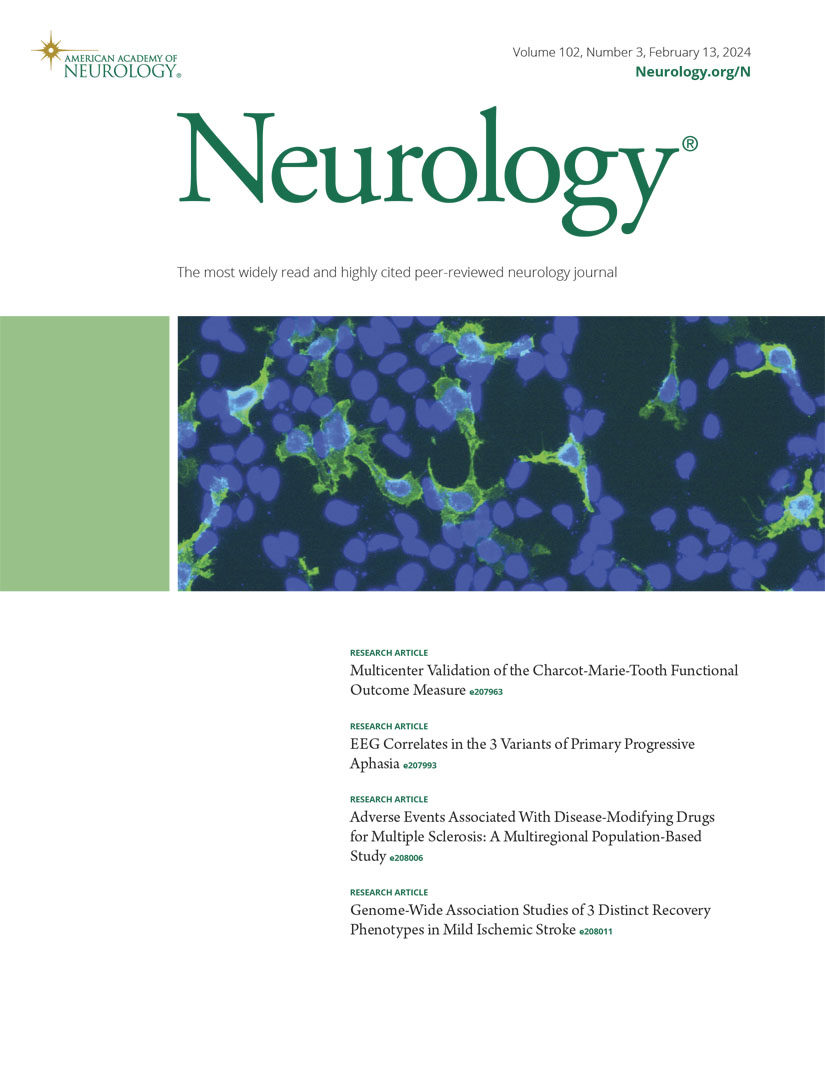Validation of the Seizure-Related Impact Assessment Scale: A Novel Patient-Reported Outcome Measure for Epilepsy.
IF 7.7
1区 医学
Q1 CLINICAL NEUROLOGY
引用次数: 0
Abstract
BACKGROUND AND OBJECTIVES There is a clear need in epilepsy clinical trials and practice for a measure that captures the trade-off between seizure and treatment-related adverse effects, which is reliable over time and across different treatment regimens. We aimed to create and validate the Seizure-Related Impact Assessment Scale (SERIAS) to fill this need. METHODS This was a prospective longitudinal study of adults with epilepsy recruited from an Australian comprehensive epilepsy center. Participants completed SERIAS at baseline and 3 and 6 months later. SERIAS has 6 self-report items. Five items record the number of days per month that seizures or treatment-related adverse effects partially or fully affect work/home/school and family/social/nonwork activities. The final item is an epilepsy disability visual analog scale. SERIAS is scored by adding the days per month of disability, with scores ranging from 0 to 150 (higher scores indicate more disability). SERIAS was completed alongside 7 validated instruments measuring seizure-related and treatment-related adverse effects (Work and Social Adjustment Scale [WSAS], Liverpool Adverse Events Profile [LAEP]), mood disorders (Neurological Disorders Depression Inventory for Epilepsy [NDDI-E], Generalized Anxiety Disorder [GAD-7]), somatic symptoms (Somatic Symptom Scale [SSS-8]), and quality of life (Quality of Life in Epilepsy Inventory [QOLIE]-31, EuroQol 5 Dimensions [EQ-5D]). General linear mixed models were used to investigate the relationship between the SERIAS and other relevant clinical and psychometric data. Standardized model coefficients β are presented with 95% confidence intervals. RESULTS A total of 90 patients (64.4% female, mean age 43.1 years) completed baseline SERIAS. Most patients reported at least 1 day of disability (62%, median SERIAS score = 3, interquartile range = 18.3). Greater disability was negatively correlated with QOLIE-31 total score (β = -0.17, 95% CI -0.27 to -0.07) and positively correlated with scores on 5-level EQ-5D (β = 0.15, 95% CI 0.04-0.25), NDDI-E (β = 0.22, 95% CI 0.13-0.31), GAD-7 (β = 0.21, 95% CI 0.09-0.32), SSS8 (β = 0.29, 95% CI 0.17-0.41), LAEP (β = 0.29, 95% CI 0.20-0.39), WSAS seizure-related adverse events (β = 0.23, 95% CI 0.14-0.33), and WSAS treatment-related adverse events (β = 0.36, 95% CI 0.26-0.46). Higher seizure frequency was associated with higher SERIAS score (β = 0.07, 95% CI 0.03-0.11). Psychometric reliability for the SERIAS was acceptable (all coefficients >0.70) as was test-retest reliability (n = 35 patients, intraclass correlation coefficient = 0.72, 95% CI 0.51-0.85). DISCUSSION SERIAS shows good psychometric reliability and strong test-retest stability. These findings suggest that SERIAS is a valid scale to measure epilepsy-related disability.癫痫相关影响评估量表的验证:一种新的癫痫患者报告的结果测量方法。
背景和目的在癫痫临床试验和实践中,明显需要一种衡量癫痫发作和治疗相关不良反应之间权衡的方法,这种方法在不同的治疗方案中是可靠的。我们的目标是创建和验证癫痫相关影响评估量表(SERIAS)来满足这一需求。方法:本研究是一项前瞻性纵向研究,从澳大利亚综合癫痫中心招募成人癫痫患者。参与者在基线和3个月和6个月后完成SERIAS。SERIAS有6个自我报告项目。五个项目记录每月癫痫发作或治疗相关的不良反应部分或完全影响工作/家庭/学校和家庭/社会/非工作活动的天数。最后一项是癫痫残疾视觉模拟量表。SERIAS通过将每个月的残疾天数相加来评分,得分范围从0到150(分数越高表明残疾程度越高)。SERIAS与7种有效的工具一起完成,测量癫痫相关和治疗相关的不良反应(工作和社会适应量表[WSAS]、利物浦不良事件概况[LAEP])、情绪障碍(癫痫神经障碍抑郁量表[NDDI-E]、广泛性焦虑症[GAD-7])、躯体症状(躯体症状量表[SSS-8])和生活质量(癫痫生活质量量表[QOLIE]-31、EuroQol 5维度[EQ-5D])。采用一般线性混合模型来研究SERIAS与其他相关临床和心理测量数据之间的关系。标准化模型系数β以95%置信区间表示。结果共90例患者(女性64.4%,平均年龄43.1岁)完成基线SERIAS。大多数患者报告至少有1天的残疾(62%,中位SERIAS评分= 3,四分位数范围= 18.3)。更大的障碍是QOLIE-31总分呈负相关(β= -0.17,95%可信区间-0.27到-0.07)和5级得分呈正相关EQ-5D(β= 0.15,95% CI 0.04 - -0.25), NDDI-E(β= 0.22,95% CI 0.13 - -0.31), GAD-7(β= 0.21,95% CI 0.09 - -0.32), SSS8(β= 0.29,95% CI 0.17 - -0.41), LAEP(β= 0.29,95% CI 0.20 - -0.39), WSAS seizure-related不良事件(β= 0.23,95% CI 0.14 - -0.33),和WSAS治疗相关的不良事件(β= 0.36,95% CI 0.26 - -0.46)。较高的发作频率与较高的SERIAS评分相关(β = 0.07, 95% CI 0.03-0.11)。SERIAS的心理测量信度可接受(所有系数>0.70),重测信度也可接受(n = 35例患者,组内相关系数= 0.72,95% CI 0.51-0.85)。讨论serias具有良好的心理测量信度和较强的重测稳定性。这些发现表明,SERIAS是一个有效的量表来衡量癫痫相关的残疾。
本文章由计算机程序翻译,如有差异,请以英文原文为准。
求助全文
约1分钟内获得全文
求助全文
来源期刊

Neurology
医学-临床神经学
CiteScore
12.20
自引率
4.00%
发文量
1973
审稿时长
2-3 weeks
期刊介绍:
Neurology, the official journal of the American Academy of Neurology, aspires to be the premier peer-reviewed journal for clinical neurology research. Its mission is to publish exceptional peer-reviewed original research articles, editorials, and reviews to improve patient care, education, clinical research, and professionalism in neurology.
As the leading clinical neurology journal worldwide, Neurology targets physicians specializing in nervous system diseases and conditions. It aims to advance the field by presenting new basic and clinical research that influences neurological practice. The journal is a leading source of cutting-edge, peer-reviewed information for the neurology community worldwide. Editorial content includes Research, Clinical/Scientific Notes, Views, Historical Neurology, NeuroImages, Humanities, Letters, and position papers from the American Academy of Neurology. The online version is considered the definitive version, encompassing all available content.
Neurology is indexed in prestigious databases such as MEDLINE/PubMed, Embase, Scopus, Biological Abstracts®, PsycINFO®, Current Contents®, Web of Science®, CrossRef, and Google Scholar.
 求助内容:
求助内容: 应助结果提醒方式:
应助结果提醒方式:


